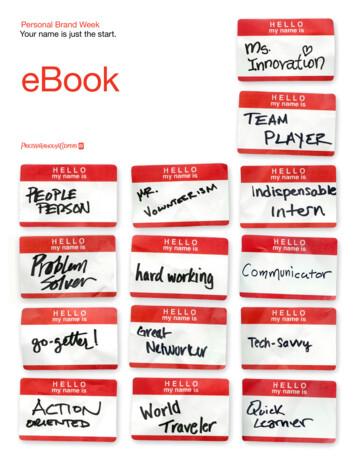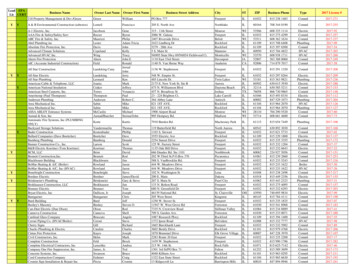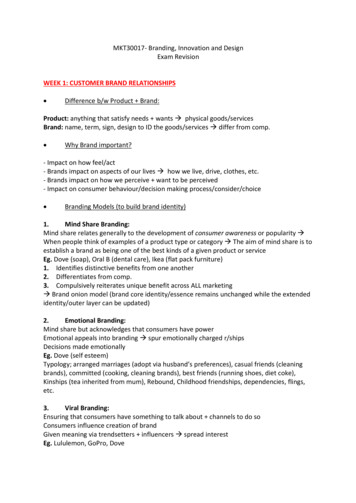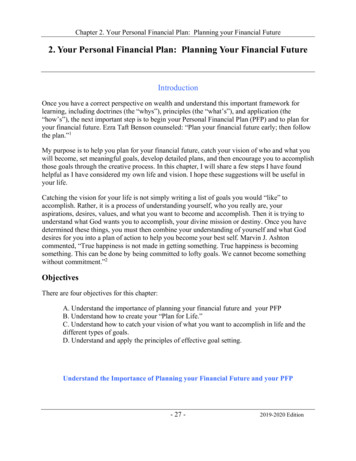
Transcription
Personal Brand WeekYour name is just the start.eBooktwitter.com/pwc us careersfacebook.com/PwCUSCareerspwc.tv
Personal Brand Weektwitter.com/pwc us In today’s competitive environment, students need a way to differentiate themselves from theirpeers. They need an “X” factor that makes them indispensable. In short, they need a personal brand.Personal branding can be a powerful tool for professional success. Personal branding is not simplya cosmetic exercise but instead a process that helps to develop skills that increase the potential ofstanding out in the crowded job market.As one of the largest employers of college graduates in the United States, PricewaterhouseCoopersLLP (PwC) has unique insights into what makes students stand out. But we’re not keeping thoseinsights to ourselves.In February 2010, PwC launched Personal Brand Week and dedicated each day to a different theme.The response from across the country was overwhelmingly positive.And now we’re taking it one step further and sharing the best personal branding tips and worksheetswith you in this e-book.Take time to read through the materials. Leverage the tips in everyday interactions. Use the worksheets to become more aware of the skills that make you different. And importantly, take actionseach day that build the personal and professional skills to create your unique personal brand.We hope that you find the materials as useful as other students across the country. And, as always,we welcome your feedback. Please visit us at facebook.com/pwcuscareers to add your thoughtsand comments.Kind regards,Holly PaulPricewaterhouseCoopers LLP US Recruiting Leader
Personal Brand Weektwitter.com/pwc us careersfacebook.com/PwCUSCareerspwc.tvThe foundationof yourpersonal brand
twitter.com/pwc us careersfacebook.com/PwCUSCareerspwc.tvMonday TipsAll About You: Top 10 Personal Branding Tips for StudentsWhat are the key elements of a student’s personal brand? Here are 10 tips to jump-start your branding efforts:1.Be authentic. Before you even think about your personalbrand, you have to think about who you really are andwhat you really want. What have you accomplished sofar? What are you passionate about? What are yourgoals? If you find it difficult to analyze yourself, askfriends or relatives to describe your best qualities andgreatest achievements or take a self-assessment testonline or through your college career center.6.Dress for success. Make sure your personal appearance matches the image you want to project. Find outwhat kind of clothes are appropriate for your desiredindustry and invest in the best you can reasonably afford.When in doubt, err on the side of formality. A greatstrategy is to have one or two reliable, high-quality outfitsthat are appropriate for a job interview or professionalevent and keep them clean and pressed at all times.2.Learn how to introduce yourself. Once you’re moreclear on who you are, the next step is being able tocommunicate that to others. “Tell me about yourself” is amuch harder assignment than it seems, especially inprofessional situations. Learn how to concisely, confidently say your name, your recent history and your goals,then practice, practice, practice until you’re comfortabletelling your own story.7.Build a professional online image. Everyone isGoogling everyone else these days, so be vigilant aboutyour online identity. Even if your social networksettings are tight, take down any photos of partying,drinking or “unprofessional” behavior just in case.Then, enhance your brand online by creating a strongprofile and becoming active on LinkedIn, the professionalsocial network.3.Show your confidence. While it’s never a good idea toproject arrogance, many students err on the side ofself-deprecation. Even if you feel inexperienced orawkward in professional situations, never make fun ofyourself or put yourself down. If you project confidenceand comfort with yourself, others will be comfortablewith you.8.Take a writing class. Guess why the “I Judge YouWhen You Use Poor Grammar” group on Facebook hasover 400,000 members? Even in the days of IM, textingand Twitter, writing and speaking skills still matter. Useproper grammar, capitalization and spelling in allprofessional communications (that means no LOLs,BRBs or ROTFLs!).4.Develop the tools of the trade. Just as a company orproduct needs marketing materials, you need variousitems to “market” yourself to recruiters, networkingcontacts, grad school admissions committees andothers. These materials include your resume, coverletters, email address, voicemail message, online profilesand website or blog. Every representation helps toreinforce the brand you want to present, so be professional and consistent across each medium.9.Ask for feedback. Find a professional you trust—afriend, relative, professor, etc.—who will be candid withyou and ask this person to tell you if there are any areaswhere you’re getting in your own way. For instance, doyou say “like” or “you know” too much? Do you comeacross as hyper, entitled or uninformed? If necessary,take a class or get some coaching in any area where youcould use some polish.5.Show your cards. Business cards are a great way toshow your professionalism and desire to keep in touchwith the people you meet, and they are increasinglypopular among career-minded students. Don’t worry ifyou don’t have a title or company; just print simple,professional-looking cards with your name, phonenumber and email address and, if you’d like, your collegeand major. VistaPrint is a good resource for free orinexpensive business cards.10. Reassess your personal brand regularly. Yourexperience, ideas and ambitions are going to evolve asyour career develops, so make sure your personal brandis keeping up. Just as you should regularly update yourresume, remember to regularly revisit your self-introduction, wardrobe, online profiles and other elements of yourpersonal brand every few months. Be flexible. “BrandYou” is always a dynamic work in progress.A Tweet from oneof our followers:paulcopcutt:Identify yourstrengths andfocus on them foryour personalbrand success,minimize theimpact of yourweaknesses#PwCPBW
twitter.com/pwc us careersfacebook.com/PwCUSCareerspwc.tvMonday WorksheetYour Elevator Pitch: The Foundation of Your Personal BrandWhat is an elevator pitch?Imagine stepping into an elevator in a downtown office building. As the doors close, the person standingnext to you says, “Hi, I’m a recruiter at your dream company. Tell me about yourself.” Are you prepared foran opportunity like this? Could you concisely introduce yourself, your background and your careeraspirations in the time of a quick elevator ride—30 seconds or less?“Elevator pitch” is a popular term for the basic introduction of who you are and what you’re looking for. Itcan be used in a variety of professional situations such as networking events, career fairs, cover lettersand formal interviews. (The elevator, of course, is optional.)Why is an elevator pitch important?In most situations, you won’t have time to tell someone your life story or to list every accomplishment onyour resume. The best elevator pitches provide enough background information and enthusiasm so theother person wants to continue a conversation with you.Here is a simple 4-step process for developing a strong and effective elevator pitch.1. Know yourself.The first step to introducing yourself effectively is knowing who you are and what makes you unique. Askyourself the following questions and jot down your answers:Which of your previous jobs, even if they were part-time jobs, internships or volunteer positions, providedyou with experience relevant to what you hope to do now? If none, what about your college major orextracurricular activities?What are your strongest skills?What are your strengths and passions, career-wise?What kinds of jobs, companies or industries are you pursuing now?
twitter.com/pwc us careersfacebook.com/PwCUSCareerspwc.tvWhat can you say about yourself that will set you apart from other entry-level job candidates? Whatmakes you memorable and special?2. Craft your pitch.Think of your pitch in three parts:1.Who are you? Remember that your primary goal is simply to introduce yourself. Share your nameand place yourself in context by explaining what school you attend, what you’re studying or whereyou currently work.2.What are your major accomplishments/passions/unique skills? Leverage the skills you listedearlier and frame them in a way that is meaningful to a potential employer or networking contact.What can you say that will make a recruiter remember you or a networking contact want to knowmore about you?3.What do you want/Where are you going? Laura Allen, founder of 15SecondPitch.com, calls thisthe “call to action.” This is the part of your pitch that lets the other person know what you’re lookingfor and the topic you’re interested in talking about. Don’t be pushy or aggressive, but do be forthrightabout the fact that you’re looking for a job.Finally, be sure to tailor your delivery to the interpersonal circumstances of the moment: the goal is tomaintain a conversational tone and not sound rehearsed. Think of the above elements as “sound bites”that you can mix, match and cater to each unique interaction.Some examples:1.“Hi, I’m Natasha Brown. I’ll be receiving my BBA in Accounting in May from UT-Austin and Iinterned last summer at PricewaterhouseCoopers in the Assurance practice. I also participated inthe firm’s community service project in New Orleans, which was an incredible experience. I’m alsothe vice president of UT’s business fraternity. I’m currently seeking an auditor position in theChicago area, which is why I’m here at this conference.”2.“Hi, my name is Rob Smith. I’m currently a junior at Boston College majoring in business with aminor in Chinese language. I spent last semester in Beijing, where I studied and had a reallyexciting internship with a small American marketing firm working with Beijing’s tourism agency. Isaw that your agency has added some Chinese clients lately, which is why I’m eager to apply forone of your internships.”3.“Hi, my name is Marcos Sanchez. I’m an English major at NYU and I’m pursuing publishinginternships. I’m really active with several organizations on campus, helping them design theirwebsites. I’m also a big advocate of social media and have helped some nonprofit organizationscreate their Facebook fan pages. I saw that your magazine is doing a lot of great things in the socialmedia space ”
twitter.com/pwc us careersfacebook.com/PwCUSCareerspwc.tvDraft your elevator pitch here:3. Consider body language.The effectiveness of your elevator pitch is not just based on what you say, but how you say it. Didyou know it takes only seven seconds for people to make 11 impressions about you? You may becompletely serious, passionate, and confident about what you have to say, but your body andclothing may be sending a different message. Image matters. When practicing and delivering yourelevator pitch, consider:-PostureEye contactVolumeToneFacial expression (smile!)ClothingHandshake4. Practice, practice, practice.Once you’re satisfied with your elevator pitch’s content and delivery, be sure to practice it enough tocomfortable and confident. If possible, try to video or audio tape yourself to see if you have any speechtics (like “um” or “you know”) or if you have a nervous habit like putting your hands in your pockets orbrushing your hair aside. Your goal should be a natural delivery that feels confident but not canned.Once you’re happy with the way your intro sounds to your own eyes and ears, try it with friends, familymembers, advisors, or career services counselors. Remember that every time you test your introductionand get feedback, you’re also getting more and more comfortable talking about yourself.Good luck!Additional Resourceswww.pwc.tv – don’t miss the rest of our Personal Brand Week Worksheets and Top 10 Listswww.15secondpitch.com – check out the free “Pitch Wizard” and “Before and After” videos5 Steps to Professional Presence: How to Project Confidence, Competence, and Credibility atWork by Susan Bixler and Lisa ScherrerYou’ve Only Got Three Seconds by Camille Lavington and Stephanie Losee
Personal Brand Weektwitter.com/pwc us careersfacebook.com/PwCUSCareerspwc.tvThe powerof passion
twitter.com/pwc us careersfacebook.com/PwCUSCareerspwc.tvTuesday TipsCarpe Diem: Top 10 Ways to Incorporate Passion into Your CareerWhat differentiates the mundaten careers from the meaningful ones? Passion is the “x” factor.Here are 10 tips on how to find and express your personal passions every day:1.Be (authentically) enthusiastic. Authentic passion isattractive and demonstrates traits like commitment,well-roundedness and enthusiasm. While networking orinterviewing for a job, don’t be afraid to express that youhave deep passions and big goals, but always stay trueto your personality and values. (If you’re shy, there’s noneed to pretend you’re a comedian!)2.Say yes more often. Be an explorer at work as well.Many people discover their calling through the movesthey make at work. Be open to new experiences—assignments, projects, trips, games, trainings, networkingevents and more. Say yes to new things—passionately.3.4.5.Find your bliss. The first step to incorporating passioninto your work is determining what you’re passionateabout. What activities, causes or topics are you mostcommitted to? What could you talk about for hours?What makes you lose track of time? If you’re not entirelysure, dedicate yourself to finding out. Remember back toactivities you loved as a kid or take some assessmenttests. Everyone has passions; find yours.Get rid of the “shoulds” and “shouldn’ts.” If you thinkit’s “bad” or “unprofessional” to show your passion atwork, you may be dealing with some predetermined fearsthat aren’t necessarily true. The reality is that passion is acare
Your Elevator Pitch: The Foundation of Your Personal Brand What is an elevator pitch? Imagine stepping into an elevator in a downtown offi ce building. As the doors close, the person standing next to you says, “Hi, I’m a recruiter at your dream company. Tell me about yourself.” Are you prepared for an opportunity like this? Could you .











